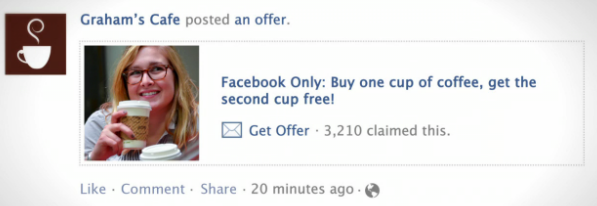Marketers don’t actually want clicks, they want the downstream conversions and the return on investment that follow. So today Facebook begins allowing advertisers using its API to ask it to show their ads to people most likely to take any specific post-click action on the social network, such as sharing a brand’s content to the news feed, buying virtual goods in their apps, or redeeming one of the new Facebook Offers at a local brick-and-mortar store. Previously Facebook’s Ads API and self-serve tool only permitted optimization for clicks, Page Likes, app installs, and check-ins. Data on conversions 1, 7, or 28 days after a click will now appear in the Ads Manager.
Rather than having to deduce what demographics are most likely to convert, and being unable to tell if those conversions came straight from ads, today’s improvements give advertisers more transparency, and will make it easier for a much wider range of businesses like social games, local businesses, and big brands to earn money from Facebook marketing.
There’s no official announcement for this but we’ve got more details. For now, the options will only be available via the Ads API, and is currently being tested with several Ads API partners who create tools and services employed by big budget advertisers to efficiently run massive campaigns. However, Facebook has been testing more optimizations in the graphic self-serve interface, so today’s improvements could appear there to help the long-tail of advertisers without the budget to use the Ads API.
Facebook has so much information on the behavior of its Facebook’s Insights Product Manager David Baser tells me the improvements “Allow people to optimize for things closer to what they want than clicks. It’s an easier mechanism for targeting. We’re trying to figure out who is most likely to take that action. It will take some time and data to learn and get really good.” Eventually, though, Facebook will know if you’re a virtual good buyer, viral sharer, event goer, or coupon clipper, and show you ads relevant to your behavior pattern.
This is all great for advertiser ROI, but also for Facebook, since if it can get the same or more clicks in fewer impressions, it has more ad inventory to sell. These data and optimizations also encourage advertisers to point their ads within Facebook where Facebook can keep racking up ad views. Facebook does not offer automatic downstream conversion optimization for ads pointing off-site, though I broke the news on an off-site conversion tracking system Facebook was quietly giving to its top advertisers.
Here’s the full list of actions advertisers can optimize for:
- People talking about this
- Page likes
- Page post likes
- Pagepost comments
- Page post shares
- @ mentions
- check-ins
- photo tags
- offers shared
- offers claimed
- App installs
- App used
- Credit spend events (number of times someone uses credits in the app)
- Credit spend amount (value of credits that were spent in the app)
- Number of RSVPs
There’s a few hugely important new advertising strategies that these new optimizations open up:
Catching Whales – Social game developers could target big spender whales by running ads pointing to their app and optimizing for “credit spend amount”. Many social games are only able to monetize a few percent of their users, and then those who spend magnitudes more than their peers make up a large portion of developer revenues. Now they can make sure their ads are getting in front of this lucrative audience, not just people who will install but never pay.
Pulling In Foot Traffic – Local businesses can now run ad campaigns that don’t just maximize click-throughs to their offers, or even downloads of the vouchers. They can actually pay to get ads shown to people who are likely to come and actually redeem the offer in person, which means both foot traffic and revenue. This way when a restaurant pays $0.25 or even $1 for a click through to their “Buy a $10 entree, get a free drink” offer, they’re much more likely to see that $10 end up in the register.
Showing Up In The News Feed – Facebook’s EdgeRank news feed sorting algorithm gives more prominence to brand Pages whose posts receive lots of likes and comments. Brands who want more visibility could run ad campaigns pointing towards especially important shared content, but then optimize for frequent commenters. The comments from those users could jack up the Page’s EdgeRank, and make their future posts appear to more of their fans.
Going Viral – Facebook’s interconnected user base can drive enormous buzz…if you can entice power users who frequently share to their huge lists of friends. Now a movie studio could optimize ad campaigns for getting their film’s trailer shared to the news feed which could generate dozens of views, rather than optimizing for a click that only generate a single view.
More Facebook advertising news:
Study: Facebook’s Ad Business Booms Before IPO With CPC Up 23%, CPM Up 15%
Buddy Media Acquires Social Ad-Buying Tool Brighter Option To Sync Paid and Owned Marketing

